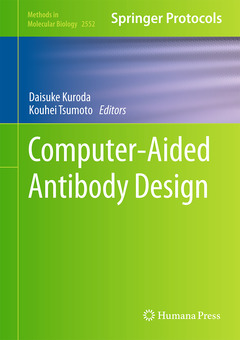Computer-Aided Antibody Design, 1st ed. 2023 Methods in Molecular Biology Series, Vol. 2552
Coordonnateurs : Tsumoto Kouhei, Kuroda Daisuke

This volume details state-of-the- art methods on computer-aided antibody design. Chapters guide readers through information on antibody sequences and structures, modeling antibody structures and dynamics, prediction and optimization of biological and biophysical properties of antibodies, prediction of antibody-antigen interactions, and computer-aided antibody affinity maturation and beyond. Written in the format of the highly successful Methods in Molecular Biology series, each chapter includes an introduction to the topic, lists necessary materials and reagents, includes tips on troubleshooting and known pitfalls, and step-by-step, readily reproducible protocols.
Authoritative and cutting-edge, Computer-Aided Antibody Design aims to be a useful and practical guide to new researchers and experts looking to expand their knowledge.
Chapter 2 is available open access under a Creative Commons Attribution 4.0 International License via link.springer.com.
1. Antibody sequence and structure analyses using IMGT®: 30 years of immunoinformatics
Marie-Paule Lefranc and Gérard Lefranc2. Structural Classification of CDR-H3 in Single-Domain VHH Antibodies
Daisuke Kuroda and Kouhei TsumotoPART II MODELING ANTIBODY STRUCTURES AND DYNAMICS
3. Computational modelling of Antibody and T Cell receptor (CDR3 loops)
Frederikke I. Marin and Paolo Marcatili
4. Molecular dynamics simulation for investigating antigen-antibody interaction
Takefumi Yamashita
5. Molecular Dynamics Methods for Antibody Design
Matthew Carter Childers and Valerie Daggett
6. Probing antibody dynamics with geometric simulations
Andrejs Tucs, Koji Tsuda and Adnan SljokaPART III PREDICTION AND OPTIMIZATION OF BIOLOGICAL AND BIOPHYSICAL PROPERTIES OF ANTIBODIES
7. PITHA: a webtool to predict immunogenicity for humanized and fully human therapeutic antibodies
Shide Liang and Chi Zhang
8. Thermal Stability Estimation of Single Domain Antibodies Using Molecular Dynamics Simulations
Gert-Jan Bekker and Narutoshi Kamiya
9. Assessing and engineering antibody stability using experimental and computational methods
Cheng Zhang and Paul Dalby
10. In Silico Prediction Method for Protein Asparagine DeamidationLei Jia and Yaxiong Sun
11. Structure-based Optimization of Antibody-Based Biotherapeutics for Improved Developability: A Practical Guide for Molecular ModelersNels Thorsteinson, Stephen R. Comeau, Jr., Sandeep Kumar
PART IV PREDICTION OF ANTIBODY-ANTIGEN INTERACTIONS
12. B-cell epitope predictions using computational methods
Dandan Zheng, Shide Liang, Chi Zhang13. Computational Epitope Prediction and Design for Antibody Development and Detection
Riccardo Capelli, Stefano A. Serapian, and Giorgio Colombo14. Information-driven antibody-antigen modelling with HADDOCK
Francesco Ambrosetti , Zuzana Jandova, and Alexandre M.J.J. Bonvin
15. Structural modeling of adaptive immune responses to infection
Tina Lusiany, Zichang Xu, Dianita S. Saputri, Hendra S. Ismanto, Sedat Aybars Nazlica, Daron M. Standley
16. Protein-Protein Interaction Modelling with the Fragment Molecular Orbital Method
Shigenori Tanaka
PART V COMPUTER-AIDED ANTIBODY AFFINITY MATURATION AND BEYOND
17. Structural Considerations in Affinity Maturation of Antibody-Based Biotherapeutic Candidates
Stephen R. Comeau, Jr., Nels Thorsteinson, and Sandeep Kumar
18. Structure-based affinity maturation of antibody based on double-point mutations
Shuntaro Chiba, Yasushi Okuno, and Masateru Ohta
19. Antibody affinity maturation using computational methods: from an initial hit to small scale expression of optimised binders
Barbara Medagli, Miguel A. Soler, Rita de Zorzi, and Sara Fortuna
20. Optimizing Antibody-Antigen Binding Affinities with the ADAPT Platform
Traian Sulea, Christophe Deprez, Christopher R. Corbeil and Enrico O. Purisima
21. Using graph-based signatures to guide rational antibody engineering
David B. Ascher, Lisa M. Kaminskas, YooChan Myung, and Douglas E.V. Pires
22. A computational framework for determining the breadth of antibodies against highly mutable pathogens
Simone Conti and Martin Karplus
23. Analytical method for experimental validation of computer-designed antibody
Aki Tanabe and Kouhei Tsumoto
PART VI SYNTHETIC ANTIBODY LIBRARY, NEXT GENERATION SEQUENCING OF B-ELL REPERTOIRES AND IMMUNOTHERAPY
24. Computational analysis of antibody paratopes for antibody sequences in antibody libraries
Hung-Pin Peng and An-Suei Yang
25. Bioinformatic Analysis of Natively Paired VH:VL Antibody Repertoires for Antibody Discovery
Ahmed S. Fahad, Bharat Madan, and Brandon J. DeKosky
26. Analyzing antibody repertoire using next-generation sequencing and machine learning
Shuto Hayashi and Shumpei Ishikawa
27. A computational pipeline for predicting cancer neoepitopes
Anna-Lisa Schaap-Johansen and Paolo Marcatili
Includes cutting-edge methods and protocols
Provides step-by-step detail essential for reproducible results
Contains key notes and implementation advice from the experts
Date de parution : 11-2023
Ouvrage de 491 p.
17.8x25.4 cm
Date de parution : 11-2022
Ouvrage de 491 p.
17.8x25.4 cm
Thème de Computer-Aided Antibody Design :
Mots-clés :
Antibodies; Drug discovery; Computational methods; Protein engineering; Biotechnology



